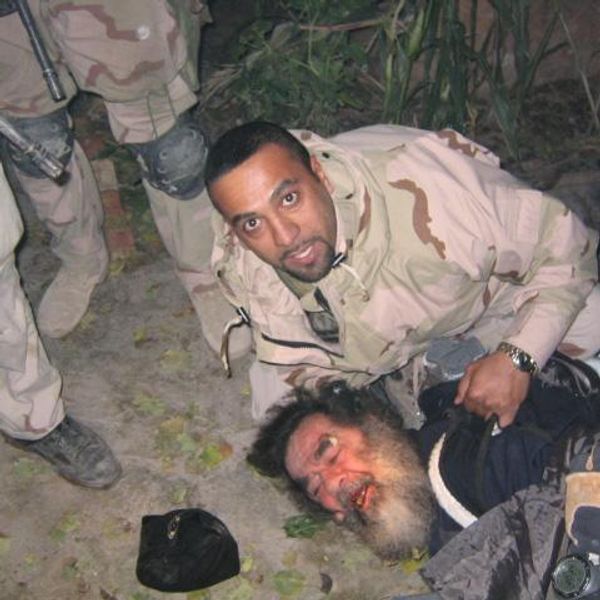Russia’s use of Iranian-made drones in the Ukraine war has garnered substantial attention in flagship US news outlets like the New York Times, Wall Street Journal and Washington Post. These papers’ first references to the matter came on July 11. Between then and the time of writing (January 24), the publications have run 215 pieces that mention Ukraine and the words “Iranian drones,” “Iranian-made drones,” “drones made in Iran” or minor variations on these phrases. That’s more than one mention per day over six-and-a-half months.
The fact that some of Russia’s drones are made in Iran is not only frequently mentioned, but is often featured in headlines like “Iran to Send Hundreds of Drones to Russia for Use in Ukraine, US Says” (Washington Post, 7/11/22), “Ukraine Warns of Growing Attacks by Drones Iran Has Supplied to Russia” (New York Times, 9/25/22) and “Russia’s Iranian Drones Pose Growing Threat to Ukraine” (Wall Street Journal, 10/18/22).
Drones are, of course, just one type of weapons export among many, and US-made armaments have not received similar coverage when they are implicated in the slaughter of innocents.
US-made bombs in Gaza
One example is Israel’s May 10–21, 2021, bombing of Gaza. According to the United Nations Office of the High Commissioner for Human Rights, the Israeli military killed approximately 245 Palestinians, including 63 children, and “totally destroyed or severely damaged” more than 2,000 housing units:
An estimated 15,000 housing units sustained some degree of damage, as did multiple water and sanitation facilities and infrastructure, 58 education facilities, nine hospitals and 19 primary healthcare centers. The damage to infrastructure has exacerbated Gaza’s chronic infrastructure and power deficits, resulting in a decrease of clean water and sewage treatment, and daily power cuts of 18–20 hours, affecting hundreds of thousands.
Israel’s attack was carried out with an arsenal replete with US weaponry. From 2009–20, more than 70% of Israel’s major conventional arms purchases came from the US; according to Andrew Smith of the Campaign Against the Arms Trade, Israel’s “major combat aircraft come from the US,” notably including the F-16 fighter jets that were bombarding Gaza at the time (Middle East Eye, 5/18/21). As the Congressional Research Service (11/16/20) noted six months before the attack on Gaza, Israel has received more cumulative US foreign assistance than any other country since World War II:
To date, the United States has provided Israel $146 billion (current, or non-inflation-adjusted, dollars) in bilateral assistance and missile defense funding. At present, almost all US bilateral aid to Israel is in the form of military assistance.
I searched the databases of the Times, Journal and Post for the equivalent terms I used for the Iranian drones used in Ukraine, and added analogous terms. In the one-month period beginning May 10, just 15 articles in these papers mentioned Israel’s use of US weapons, approximately half as many stories as have been published on the Russian use of Iranian-made drones each month.
‘Strongly backing’ attacks on Yemen
A grisly case from the ongoing Yemen war is another worthwhile comparison for how Iranian weapons exports and their US counterparts are covered. On January 21, 2022, the US/Saudi/Emirati/British/Canadian coalition in Yemen bombed a prison in Sa’adah, killing at least 80 people and injuring more than 200. The US weapons-maker Raytheon manufactured the bomb used in the atrocity.
In coverage from the month following the attack, I find evidence of only two articles in the three papers that link the slaughter and US weapons. A New York Times story (1/21/22) raised the possibility that US-made bombs killed people in Sa’adah:
It was unclear whether the weapons used in the airstrikes had been provided by the United States, which in recent years has been by far the largest arms seller to Saudi Arabia and the [United Arab] Emirates, according to the Stockholm International Peace Research Institute, which monitors weapons transfers.
The one piece that explicitly pointed to US culpability in the Sa’adah massacre was an op-ed in the Washington Post (1/26/22) that referred to “ample evidence showing US weapons used in the attack.” Thus the Wall Street Journal didn’t consider US participation in a mass murder that killed 80 people to be newsworthy, and the Times and Post evidently concluded that US involvement merited minimal attention. The Post (1/21/22) even ran an article that misleadingly suggested the US had ceased to be a major factor in the war:
The United States once strongly backed the Saudi-led coalition. But President Biden announced early last year that Washington would withdraw support for the coalition’s offensive operations, which have been blamed for the deaths of thousands of civilians. The Trump administration had previously halted US refueling of Saudi jets operating against the Houthis. Some members of Congress had long expressed outrage over US involvement in the war, including weapons sales to Saudi Arabia.
Yet mere weeks before Sa’adah killings, Congress signed off on a Biden-approved $650 million weapons sale to Saudi Arabia (Al Jazeera, 12/8/21). That means Washington is still “strongly back[ing]” the coalition, notwithstanding the hollow claims that such weapons are defensive (In These Times, 11/22/21).
‘Expanding threat’
The coverage of Iran’s weapons exports and the US’s also diverges in terms of the analyses that the outlets offer.
David Ignatius told his Washington Post (8/24/22) readers to “beware the emerging Tehran/Moscow alliance.” In the periods I examined, there is a marked shortage of articles urging readers to “beware” the Washington/Tel Aviv or Washington/Riyadh alliances, despise the bloodshed they facilitate.
The Wall Street Journal (10/28/22) contended that
Russia’s expanding use of Iranian drones in Ukraine poses an increasing threat for the US and its European allies as Tehran attempts to project military power beyond the Middle East.
The article went on to say that “the Western-made components that guide, power and steer the [Iranian] drones touch on a vexing problem world leaders face in trying to contain the expanding threat.” The piece cited Norman Roule, formerly of the CIA,
warn[ing] that the combination of drones and missiles one day might be used against Western powers. “This Ukraine conflict provides Iran with a unique and low-risk opportunity to test its weapons systems against modern Western defenses,” Mr. Roule said.
The US weapons that helped lay waste to Gaza and snuff out dozens of prisoners in Sa’adah are barely presented as having harmed their victims, and not at all as an “increasing” or “expanding” threat to rival powers such as Russia or China, or to anyone else.
‘Malign behavior’
In the New York Times (11/1/22), Bret Stephens contended that the Biden
administration should warn Iran’s leaders that their UAV factories will be targeted and destroyed if they continue to provide kamikaze drones to Russia, in flat violation of UN Security Council Resolution 2231. If Tehran can get away with being an accessory to mass murder in Ukraine, it will never have any reason to fear the United States for any of its malign behavior. Every country should be put on notice that the price for helping Moscow in its slaughter will be steep.
Of course, the UN charter does not give individual countries the right to attack other nations they perceive as violating UN Security Council resolutions. And needless to say, the Times, Journal and Post do not say that US responsibility for mass murder in Palestine and Yemen means that weapons factories in the US should be “targeted and destroyed” by a hostile power. Nor do they suggest that the US should be “put on notice” that there will be a “steep” “price for helping” Tel Aviv or Riyadh in their “slaughter.”
William B. Taylor and David J. Kramer argue in the Post (12/6/22) that Iranian drones are among the few “Russian weapons that work,” and that the US needs to “provid[e] Ukraine with missile defense, anti-drone and antiaircraft systems.” None of the articles I examined said that anyone should give military hardware to the Palestinians or Yemenis for protection against US-made weapons.
If these outlets’ concern about Iranian arms exports to Russia were about the sanctity of human life, there wouldn’t be such a gap between the volume and character of this coverage compared to that of US weapons piling up corpses in Palestine and Yemen. Instead, corporate media have focused on how official enemies enact violence, and downplayed that which their own country inflicts.
This piece has been republished with permission from FAIR.
















